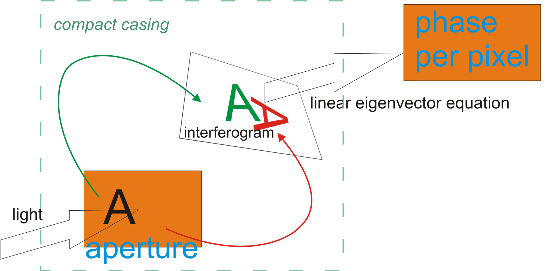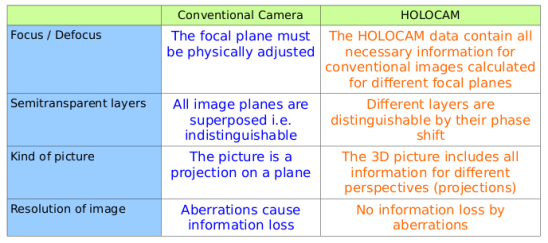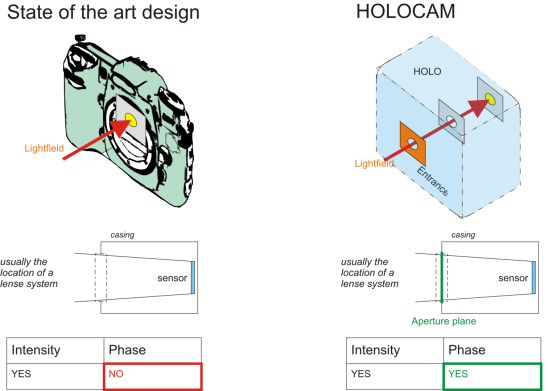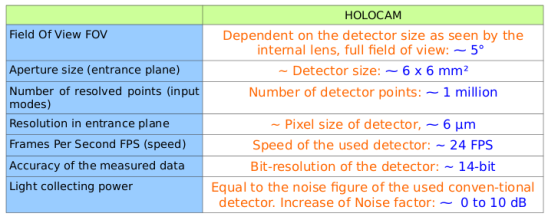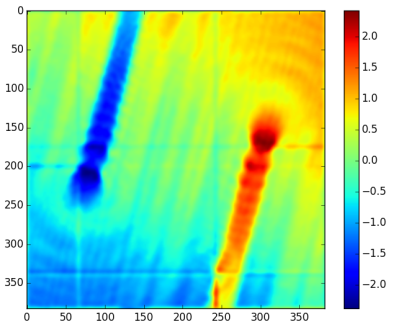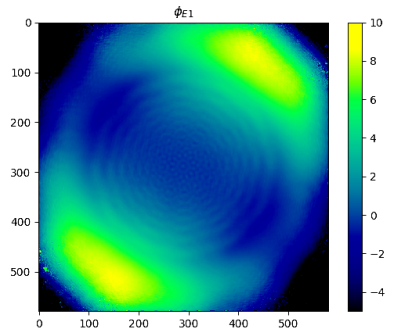HOLOCAM is the first known phase sensitive camera without reference beam, i.e. a real holographic camera.
3D HOLOCAM interferometers at arXiv:
Twisted 3D holograms for self-referencing interferometers in metrology and imaging
https://arxiv.org/abs/1611.08092
The HOLOCAM in context at arXiv:
A new non-iterative self-referencing interferometer in optical phase imaging and holographic microscopy, HOLOCAM
https://arxiv.org/abs/1611.05765
An introduction to the method is published at arXiv:
Unbiased (reference-free) phase field imaging for general optical fields including phase discontinuities
HOLOCAM Holographic Camera
Contrary to regular camera systems, the presented Holographic Camera HOLOCAM measures on every pixel not only the intensity but also the phase of light. The ’HOLOCAM’ is thereby system compatible to regular cameras, but better preforming. This is achieved by internal generation and evaluation of an appropriate interference pattern. For this, a 3D-shaped interferometer inside of the HOLOCAM casing is used. As any regular camera the HOLOCAM does not contain an internal light source but all the light comes from the external source.The user of the HOLOCAM does not need to know these internals. He can use the camera as any other camera.
It is well known from holography that the phase of light can be measured. For this purpose a light wave scattered from an object is brought to interference with a reference beam which has to be sorted out from the illuminating source (usually a laser). This is only feasible if such a reference beam exists which is neither always the case nor practicable. The hole system becomes a large interferometric setup, which must be very stable. This inherent problem of interferometric systems is solved for the HOLOCAM, using holographic methods only internally. It means "reap the benefits of holography, whithout having its drawbacks".
The presented HOLOCAM does not need a reference beam. As a consequence the HOLOCAM allows to analyse the intensity and phase of arbitrary light fields independent of their origin. Preferentially some coherence should exist since otherwise it would be eventually needless to use a HOLOCAM. But even for this extreme case the HOLOCAM can reconstruct the spatial distribution of the incoherent sources and their frequency spectrum.
The remarkable properties of the HOLOCAM are achieved inside of the camera by a two-beam interferometer and 3D field transport, which mutually turns (or winds) the spatial fields (Such phenomena are known from differential geometry, from Berry’s phase or Pancharatnam–Berry phase.). For this type of interferograms an evaluation theory has been found which reduces the phase extraction to the solution of a linear eigenvalue problem. Actually the eigenvector to the lowest eigenvalue (or the groundstate) has to be calculated. This process is linear, stable and local. “Local” means that local disturbances only perturb the local field but not the entire solution in other spatial areas.
The mathematical technique is exact in the sense that no limiting approximations need to be made. It is systematic and fully compatible to Fourier analysis (in time and space). This allows to combine the HOLOCAM theory with well known theoretical approaches used in modern optics. As a result the response of the HOLOCAM to polarized light, short pulses, incoherent light, etc. can be predicted by systematic text book analysis.
The HOLOCAM has been successfully tested in laboratory. The high resolution has been verified experimentally.
Shown are two test cases.
1) The phase image of wires in space:
2) The phase phi of the light 25 cm behind an IRIS diaphragm.
Applications of the HOLOCAM
Optical metrology
- Autocollimator (the concept of direction/angle/distance/speed)
- Characterization of free form surfaces (*)
- Calibration, quality control
Adaptive optics (market value 2016: 10 Bill. $, + 20 % p.a. )
- Astronomy (*)
- Ophthalmology (*)
Surface probing
- Thin film evaluation, ellipsometry (*)
- multi-λ techniques (synthetic band pass filter)
Holographic imaging (market value 2014: 0.8 Bill $, + 37 % p.a.)
- 3D bio imaging, machine vision (multi-k, multi-λ) (*)
- Chemical imaging, coherent non-linear optics
- Tomography (synthetic aperture)
Communication, Light as information carrier
- Optical communication
- encryption
For the topics with (*) HOLOCAM design examples are available.
The HOLOCAM has the potential for widespread use with little requirements on its users.
the HOLOCAM-project
The HOLOCAM-project tries to bundle scientific and industrial efforts to bring the HOLOCAM to market. Interested parties are invited to contact Dr. Martin Berz / IFE GmbH.
The following services are available for partners of the HOLOCAM project:
- A complete evaluation guide for phase determination, including the software for numerical propagators, solvers and visualization.
- A design and simulation software tool for the HOLOCAM.


